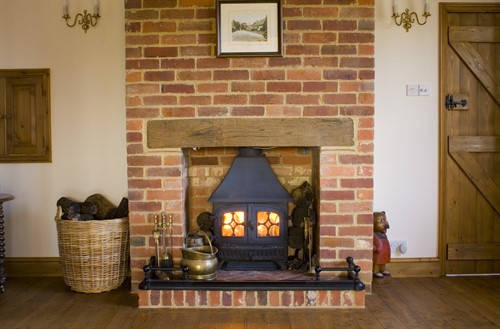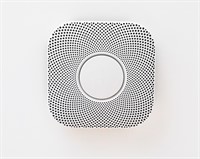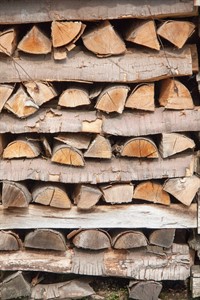Posted on 02/12/2016 by David
Open fires and log burners are a popular feature adding character and warmth to a room, particularly appreciated on a winter’s evening. Offering this feature may improve your property’s desirability but some care and attention must be given to ensure it’s safe and provides the guests with a good experience.
The biggest concerns are around chimney fires (every year there are approximately 10,000 chimney fires in the UK, accounting for around 15% of all fires in houses) and carbon monoxide poisoning. This blog offers some guidance on providing your guests with a safe fire.

Installation
Fire installation is covered by building regulations part J, complying with these and other requirements is easily done by using a professional to undertake any work for you. They will check that the fire is appropriate for the room, the flue is correctly installed with a good seal to prevent smoke escaping to other parts of the house and away from combustible material, for example insulation in the attic. HETAS is the government approved body which approves solid fuel burning appliances and registers competent installers. Your insurance will require appropriate certification of any work done.
If a fireplace is being reopened it will need to be inspected to make sure it’s free from obstructions and still safe. For example, over time smoke deposits can react with the lining of the chimney or flue to the point that it needs relining. Typically relining is done by installing a tube into the chimney with insulation placed between it and the walls of the chimney.
What’s the difference between a chimney and a flue? A chimney is a structural part of building whereas the flue is the pipe along which smoke flows, this may be inside a chimney or on its own.
Back Boilers
If you have an old chimney there is a chance a back boiler is installed (this heated water for the house from the warmth of the fire). Ideally this should be removed as they can explode due to a build up of steam created from water trapped in the system, see the HSE guidance for more information.
It is a legal requirement for a carbon monoxide detector to be installed in any room with a fuel-burning appliance.

You may also consider installing one in any room through which a flue or chimney passes in case of an unexpected leak. Carbon monoxide (CO) is produced when fuel is burnt without adequate ventilation and the fire doesn’t have enough air to burn properly. One cause of poor ventilation is a blockage in the flue, for example a bird’s nest. Even with a clear flue, some houses have airbricks or vents installed to make sure that enough air flows into the room.
Chimney Terminals
If you find sticks in the fire place that have obviously come down the chimney it’s a good sign that birds are nesting. If this is a problem you could install an approved bird guard (sometimes known as a chimney terminal). Jackdaws seem to be particularly keen to build nests in chimneys. Other reasons you might consider a chimney terminal are for protection from the weather or if you have downdraft issues causing smoke to flow back into the room. In extreme cases you may need to install a fan to pull the air upwards. It’s important the right terminal is used and provides adequate air flow so seek professional advice. Some terminals are designed specifically for chimneys that have been closed off and are not suitable for use on chimneys that are in use.
Maintenance
With each burning a deposit of soot and tar can build up in the flue which could catch fire or reduce the flow of air and smoke. Over time these deposits may also react with the lining of the flue causing corrosion and reducing the integrity of the smoke seal. In chimneys that have been closed off for a while the damp can accelerate these reactions so if you are bringing a chimney back into service it will need to be inspected first. Sweeping the chimney will remove this build up as well as any other items that become caught in the chimney such as birds’ nests, masonry or cobwebs. Traditionally chimneys are brush swept though chemical sweeps can be offered too. Generally it is recommended to do a brush sweep as this will also remove any debris from the chimney. Frequency depends on the type of fuel burning and how often the fire is used. There are a range of opinions but the sweeping Industry suggests a 3 monthly sweep during the “heating season” for wood burning fires. As occupancy in self-catering properties tends to be lower in the “heating season” it may not be necessary to do it that often. In any case, chimneys should be swept at least once a year and you will probably find this is a requirement of your insurance. If you ever have to make an insurance claim you will probably have to present a certificate to prove this work has been done so make sure you use a chimney sweep with a recognised accreditation. The meshes used in bird guards are likely to become sooted up over time and will also need cleaning periodically.
Using the fire
Not all guests in your house will be familiar with lighting fires so make sure that clear instructions are provided. Guests will need to know:
Type of fuel:

Different fires are suitable for different types of fuel so refer to the manufacturer/installer for advice. For example, burning coal in a log burner will not produce much heat but will quickly create a build-up of soot in the flue. In many cases the fuel to use is wood. Wood should have less than 17% water content to burn efficiently and reduce the amount of tar building up in the chimney – if you store wood it should ideally be kept under cover but, most importantly, well ventilated so moisture can escape. It’s a good idea to supply the wood so guests will use it as opposed to other things they might try to burn on the fire.
How to operate any air inlets:
If your fireplace or log burner has any air vents that need opening or closing explain how to operate them and what positions they need to be in to start the fire and control it.
How to light a fire:
Explain to guests how to build up the fire using kindling, to make it easy supply fire lighters – the wrapped ones are most user-friendly – kindling and at least enough fuel for a couple of evening fires and advise guests as to where they can buy more fuel.
Warnings:
- Do not use starting liquids for barbeques or similar as they can create a rapidly burning fire beyond the capacity of the fireplace or log burner.
- Paper, cardboard boxes and plywood are not suitable for burning as they increase the chances of a chimney fire. Likewise general rubbish should not be burnt on the fire as items like crisp packets may be blown up the flue and block it causing the fire to produce carbon monoxide.
- Piling fuel high into the fireplace or log burner is not advisable as it increases the chance of a chimney fire. Flames should fill the fireplace or burner and not reach up into the chimney or flue.
- Fires should be attended at all times and definitely not left overnight. Some people like the idea of having the fire burn slowly through the night but to do this you have to reduce the airflow right down in a log burner at which point the fire burns at a low temperature causing incomplete combustion and lots of tar (this normally burns as a gas in the higher temperatures) which condenses on the lining of the flue providing fuel for a chimney fire. The fuel should always be burning and not permitted to smoulder.
Correct equipment
- Fire guard to prevent sparks flying out of an open fire and to keep small children away
- A brush, metal dustpan and metal bucket to clear the ashes
Summary
It all sounds a bit onerous but to put this in perspective open fire places have rarely caused any problems for us and it’s usually running out of logs that is the biggest issue! By ensuring the chimney is regularly maintained and the guests are provided with suitable instructions and equipment you should have a trouble free experience.
Checklist:
Installations should comply with approved Document J of the Building Regulations which covers combustion appliances and fuel storage systems.
A carbon monoxide detector must be installed in any room with a log burner or open fire place.
Chimneys must be swept a minimum of once a year
Suitable equipment and instructions must be provided for guests
The most common causes of chimney fires are:
- Burning unseasoned wet wood
- Not sweeping and cleaning the chimney
- Smouldering wood for long periods in log burners
- Using the wrong fuel
Further Information
Installation:
Chimney Sweeps:
NACS national association of chimney sweeps
The Association of Professional and Independent Chimney Sweeps
Maintenance and Inspection:
http://www.bfcma.co.uk/maintenanceinspection.aspx

